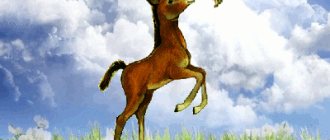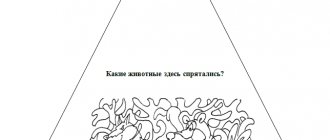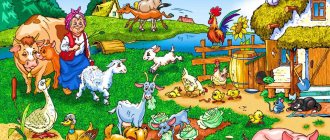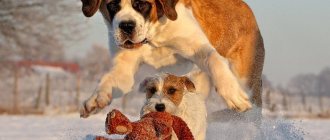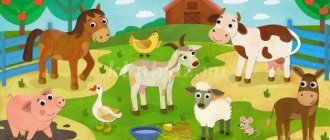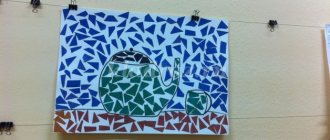Parrots
Domestic parrots breed just as well in captivity as their wild counterparts. The main thing is to observe a number of simple conditions, such as the presence of a “birdhouse”, temperature conditions, long daylight hours, and proper nutrition. If the male parrot is not aggressive towards the female hatching the clutch, then there is no need to remove him - he will look after the family. Chicks appear in small species within two and a half weeks, in large species after a month. Find out more about the types of pet parrots here. During the first week, the chicks have no feathers, no down, and their eyes are closed. On the seventh day, the eyes open, after two weeks the babies become pubescent, and after a month and a half they begin to fly, if we are talking about wavy birds. Larger parrots mature later.
Baby wild animals
The names of the cubs of many wild animals are similar to the names of domestic babies.
Tigers, cheetahs, pumas, lynxes, jaguars belong to the cat family. Their children are called kittens, for example, a lynx kitten.
Foxes, wolves, jackals are relatives of dogs. Dog cubs are called puppies, that is, a wolf baby will be called a wolf pup. The name wolf cub and fox cub are also correct.
There are names that repeat the name of the parents: lion cub, tiger cub, elephant calf, kangaroo cub, bear cub, deer cub.
Dogs
Baby dogs are called puppies. Everyone knows these cute fluffy lumps from which our faithful friends and protectors grow. But you shouldn’t breed tailed animals on your own; it’s better to entrust this to nurseries.
Puppies appear with their eyes closed and the simplest reflexes of searching for their mother and her milk. But a little more than a week will pass, and the kids begin to see and explore the world around them. Two weeks later they are already trying meat food, and after a month the healthiest cubs are already getting used to living without their mother.
Cats
Kittens are born very tiny, blind and deaf. They still lack the vital undercoat, so only the warmth of their mother cat saves them. But their sense of smell is well developed, and with its help they search for a source of milk. By about the fifth day they can hear well. Up to a week of age, they sleep almost without interruption, waking up only to eat.
The eyes open only at the end of two weeks. At this time they are already fluffy and begin to crawl around the nest.
At three weeks they are already almost full-fledged “mini-cats”. It's time to give complementary foods, socialize the babies, and tame them to the hands and tray. But it is recommended to wean the cat from two months. These animals grow for up to a year, and finally become stronger at two years.
Hamsters
Like any rodents, hamsters, large and small, are very fertile. But you shouldn’t use this and breed dozens of little animals at home. If you already know in advance where you will place the hamsters, read in detail about organizing their breeding.
Hamster chicks appear completely blind and without hair, so they are very dependent on the mother hamster for the first week of life; she feeds them every hour, day and night. On the 8-9th day they already try some vegetables and cottage cheese, which should be given to the hamster every other day. At the age of three to four weeks, the babies are seated by gender, and after a few days, one at a time.
Giraffe
Giraffes have a memorable appearance - a long neck, horns, eyes with long eyelashes. Each giraffe has an individual pattern on its skin. Animals run and jump well, but cannot swim. The giraffe has excellent eyesight; it can see its fellow tribesmen at a distance of 1 km.
What is the name of a baby giraffe? The giraffe is a distant relative of cows, which is why its baby is called a calf. In modern dictionaries there is the option “giraffe”.
Rice. 2. Baby giraffe.
Guinea pigs
Guinea pigs stand out from most young domestic animals. Amazingly, newly hatched piglets can immediately explore a new world because they already see, hear and are covered in fur. But that doesn't mean they aren't vulnerable! They should not be touched for at least a week, so as not to damage the delicate bone structure and not to disturb the smell by which the mother pig identifies them.
Sow piglets are fed milk for about three weeks, but they cannot be weaned before one month of age.
You should not breed guinea pigs on your own and simply keep different-sex individuals together: there is a high risk of emergency situations and losses among the cubs and females.
Notes on the world around us for the younger group in kindergarten. Pets and their babies
Summary of a lesson on the surrounding world for younger preschoolers “Pets and their cubs”
I present to your attention a summary of a lesson on the surrounding world for teachers of the 2nd junior group on the topic “Pets and their cubs”. The lesson is designed for children 3-4 years old. I conducted this lesson with children at the beginning of the week on the lexical topic “Pets”, in the morning, the lesson lasts 15 minutes. Goal: to introduce children to domestic animals and their cubs. Objectives: 1. learn to name pets; 2. teach to compare animals by size; 3. develop memory, love for animals; 4. develop attention and speech; 5. activate and enrich your vocabulary. Planned result: 1. be able to guess riddles based on verbal descriptions; 2. teach how to look at illustrations; 3. be able to talk about what is shown in the picture. Progress of the lesson: Educator: Hello, guys. Today different animals came to visit us. (on the magnetic board there are images of animals: cow, cat, horse, dog) Listen to the riddles and try to guess the names of the animals. Riddle 1 - She has horns, hooves, and looks angrily at everyone. But she is kinder than a puppy, and will pour us milk. Children: Cow . Educator: Well done guys, that's right, cow! (I show a picture of a cow). I say that the cow has what on its head? - Horns, eyes, ears, mouth. The cow chews grass and gives milk! Riddle 2 - He’s crying at the threshold, hiding his claws. He will quietly enter the room, purr, and sing. Children: Cat, cat. Educator: That's right, cat. (I show a picture of a cat) I say that a cat has ears, eyes, a nose, a mouth and whiskers on its head. The cat catches mice, it is pleasant to stroke its fur. Riddle 3 - I have a big mane, ears and hooves. I'll give him a playful ride, who isn't afraid. My fur is smooth, Who am I?... Children: Horse . Educator: That's right, guys. (I show a picture of a horse). I say that the horse has a mane, tail and hooves. You can ride a horse. Riddle 4 - Lives in the yard, In a private house-kennel, And at everyone she doesn’t know, She either growls or barks. Children: Dog . Educator: Dog, well done guys. (I show a picture of a dog). I say that the dog has 4 legs, a tail, and ears. A dog is a person’s friend, it guards the house, you can go hunting with it. Educator : Well done, guys, you guessed all our guests. What can you call all these animals? What are they? Children: Homemade Teacher: Why are they called homemade? Children: Because they live in the house and in the yard. Educator: That's right, guys. And I also have pictures of their cubs. The only problem is, they are all mixed up. Let's try to give each animal its own baby, shall we? Educator: The dog has a small... puppy
.
Katya, go to the board and take the little puppy to your mother. (the child attaches a picture of a puppy to a dog). And the cat has a small... kitten
.
Olya, go to the board and help the little kitten find its mother. (the child attaches a picture of a kitten to a cat). The cow has a small... calf
.
Sasha, come out and take the little calf to your mother. (the child attaches a picture of a calf to a cow). The horse has a small... foal
.
Seryozha, go to the board and help the little foal find its mother. (the child attaches a picture of a foal to a horse). Educator: Guys, tell me, do you know how animals take care of their young? They feed them milk, clean their fur with their tongue, protect and warm them. How do animals take care of their young? Children: repeat the teacher’s answer. Physics minute “Kitty”: Here’s a kitten, sneaking around in a circle, one after another on its tiptoes.
Round face,
stop, show the face with both hands, shake their head.
And on each paw
they rhythmically extend their left hand, then their right.
Scratchy claws.
All his toys are jumping on their toes, holding their hands on their belts.
Cube and reels.
The cat, like a ball, bounces and moves in a circle one after another.
Jumps around the apartment.
Game "Feed the animals" . A kitten and a puppy are sitting on the table. Educator: Guys, tell me, what do you think the kitten likes to eat? Children: milk, sour cream. Educator: That's right, guys. I invite one child to bring a toy plate, another to “pour” milk from a bottle, and a third to place the plate near the cat. Guys, what do you think the puppy likes? Children: bones, bread. Educator: Good guys, guys. Let's feed our puppy too. I suggest feeding him a bagel. Educator: The kitten and puppy ate and went to bed. And it's time for us to finish our lesson. Guys, tell me what animals we saw in the pictures? What are their cubs called? Who did we feed and put to bed? What did you feed? Why are our guests called pets?
We recommend watching:
GCD summary in the 2nd junior group on the topic “Friends for the Snowman” GCD summary for mathematical development in the first junior group GCD summary for the development of cognitive abilities in the first junior group
Similar articles:
Summary of an integrated lesson in the 2nd junior group
Rats
If you decide to start breeding rats, then get ready for a significant increase in the number of animals: a rat will produce from 6 to 15 cubs at a time.
Home decorative rat with cubs
In the first days after birth, rat pups are small, naked and blind lumps. But by the week their appearance changes significantly. The rat begins to bring them food as complementary food, and it’s time to hold them for a while for socialization. Boys have been growing up for five weeks, and females only at four months.
Zebra
Zebras are related to horses and behave like horses - they run, jump, chew grass, and live in large herds. A baby zebra is called a foal. The baby stands on its feet soon after birth and can run after its mother within an hour. The pattern on the zebra's body is unique, and the baby recognizes its mother by it.
In 2021, a small zebra with a brown coat and white spots was discovered in Kenya. It turned out that the baby was deficient in a substance that is responsible for proper coloring. The herd adopted an unusual baby.
Rice. 3. Spotted baby zebra.
African hedgehog
Long-domesticated African hedgehogs do not immediately become prickly. Just like many pets - they appear bald and blind and with a hint of soft quills. For the first two weeks, the hedgehog should not be disturbed in any way, so that for protection purposes she does not eat the offspring.
If after this period the female is quietly resting outside the nest, you can begin to tame the hedgehogs. It is advisable to do this every day so that the animals grow up tame.
At one and a half to two months, hedgehogs begin to feed on their own, and then they can and should be separated from the hedgehog.
The hedgehogs have already grown up and are covered with needles
Sheep
A sheep is a ruminant animal with thick wool and horns. Sheep's legs are adapted to move in the mountains, where they can climb rocky ledges. The buildings for sheep, the sheds, are not heated, since the wool needs cold to thicken.
Sheep wool, meat, and milk are used. Lanolin is obtained from the fat covering wool.
Rice. 2. Sheep with lamb.
stick insect
Another pet that knows how to surprise is the cute and harmless stick insect. These creatures can reproduce even without a partner! Usually these are females and the offspring appear entirely female.
For stick insects to begin to reproduce in captivity, they need suitable conditions and soil, which you can read about here. Babies emerge from eggs and mature through several molts. The molting insect falls into a stupor and does not move; the main thing is not to disturb it at this vulnerable moment.
Cat, Guinea pig, parrot, Birds, Dog, Hamster, Exotic
